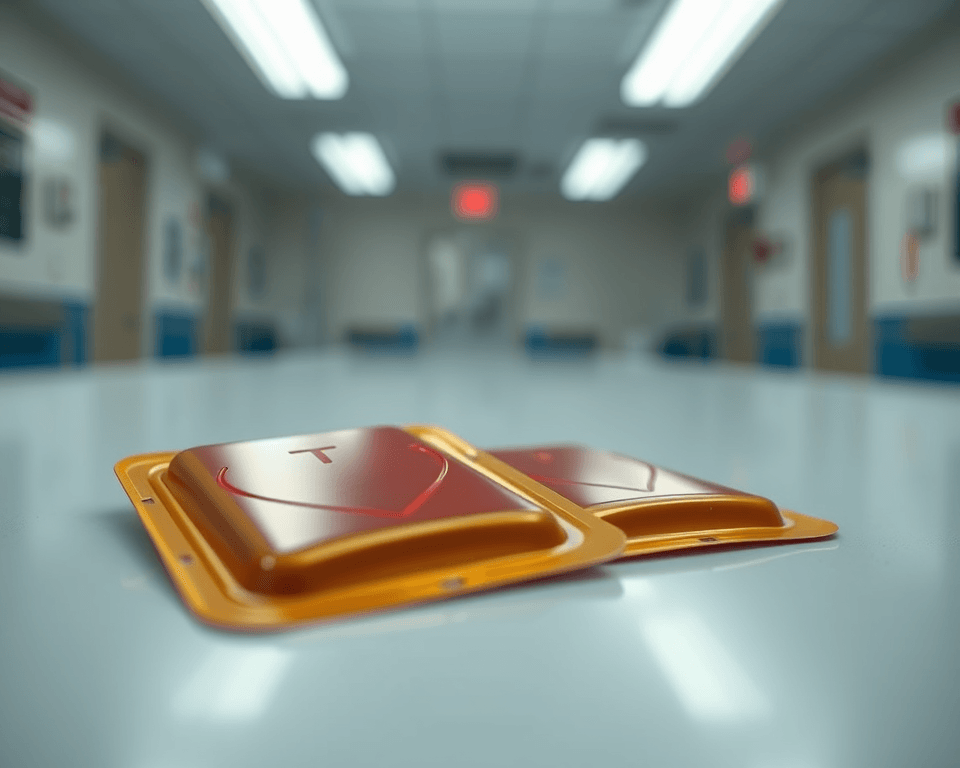You’re at a gathering, and suddenly, someone collapses. Heart racing, you rush over and check for a pulse. Someone calls 911, but you feel this overwhelming urge to do something, and that’s where an AED steps in. But let’s talk pads—specifically, self-adhesive AED pads. You might think, “Why should I care about the type of pads?” Well, let me tell you: these little rectangles can make a lifesaving difference during those precious minutes in an emergency.
Key Takeaways
- Self-adhesive AED pads improve stability and ensure effective shock delivery, making them vital for resuscitation.
- The quick application process allows first responders to focus on the patient rather than fumbling with equipment.
- Real-life testimonials and case studies consistently show improved survival rates with self-adhesive pads.
- Regular maintenance and proper selection of high-quality pads can significantly enhance AED performance in emergencies.
1. Understanding Self-Adhesive AED Pads
Alright, let’s break this down. You may be familiar with AEDs (Automated External Defibrillators) and how they deliver life-saving shocks to restore a normal heart rhythm during cardiac emergencies. Self-adhesive AED pads are the magic tickets in this equation, designed to stick securely to the patient’s chest regardless of the situation.
1.1 How Self-Adhesive AED Pads Work
Imagine you’ve just found an unconscious person. The last thing you want to worry about is whether the pads are gonna stay put as you try to deliver a shock. These self-adhesive pads are equipped with a strong gel that adheres tightly, ensuring the electrodes remain in place even if the patient shifts during resuscitation efforts. This is crucial: the pads need to accurately detect the heart rhythm and deliver electrical signals precisely when it counts.
Every time the AED analyzes the heart rhythm, it checks if a shock is necessary. If it is, the pads provide clean, quick, and effective shock delivery. An effective pad mechanism is key here; they can literally be the difference between life and death.
1.2 Differences Between Self-Adhesive and Traditional AED Pads
Now, let’s throw some light on how these self-adhesive pads stack up against the traditional ones. Traditional pads often rely on adhesive systems that can lose their stickiness over time or under pressure, leaving you with a potentially ineffective setup. Talk about a nightmare!
Self-adhesive pads, on the other hand, use a better adhesive technology, allowing for improved usability in emergencies. Think of it as the battle of reliability during a crisis. When every second counts, you want to ensure you’re using a pad that won’t give up when needed the most.
2. Benefits of Self-Adhesive AED Pads
When considering an AED setup, benefits range from improved survival rates to user-friendly application processes. Let’s unpack this!
2.1 Enhanced Adhesion and Stability
Have you ever tried sticking something on a wall, but it keeps peeling off? Frustrating, right? In the context of AED pads, improper adhesion can lead to serious consequences. Self-adhesive pads boast enhanced adhesion, ensuring they stay put during critical moments.
- They stick well to the skin, making them highly effective for shock delivery.
- Patients can move or be repositioned without compromising the pad’s integrity.
In a way, these pads are like the ultimate sidekick—you want them always to be there and reliable when the going gets tough.
2.2 Simplified Application Process
Let’s face it: when you’re in a high-stress situation, the last thing you want to do is mess around with complex equipment. Self-adhesive pads streamline the application process, making it easier for both trained professionals and laypersons.
Picture this: You arrive on the scene, and within seconds, these pads are on the patient. Thanks to their intuitive design, you simply tear them off and stick—no fuss, no stress. Studies have shown that a quicker application can lead to better outcomes in emergencies, and who doesn’t want that?
3. Evidence of Effectiveness
Let’s get into the nitty-gritty and talk numbers. When you’re considering AED pads, it’s essential to look at the data.
3.1 Case Studies Showing Impact
Various studies have shed light on the effectiveness of self-adhesive AED pads in real-life scenarios. For instance, a study published in The American Heart Association Journal found that patients had significantly improved survival rates when treated with self-adhesive pads during out-of-hospital cardiac arrests.
“In emergencies, the right AED pads can mean the difference between life and death. Choosing self-adhesive pads boosts your chances of a successful resuscitation.”
Imagine hearing that from an expert! Those statistics are a powerful motivator for anyone who may one day find themselves in that situation.
3.2 Testimonials from Emergency Medical Technicians
As someone who’s trained in emergency response, I’ve heard rave reviews about self-adhesive AED pads from EMTs. These front-line warriors often share stories about how they encounter chaotic scenes, and every tool in their kit needs to be top-notch.
One EMT recounted a harrowing experience where they rushed to a cardiac arrest case and highlighted how quickly they could apply the self-adhesive pads, leading to a successful shock and resuscitation.
“I trust these pads because they stay in place and do what they’re supposed to do. In those split seconds, every little detail matters.”
That’s what we want—trustworthy equipment that delivers results.
4. Practical Applications and Maintenance
So you’ve invested in high-quality self-adhesive AED pads. Now what? It’s essential to maintain them to ensure they are ready to go when the moment arises.
4.1 Regular Inspections and Replacements
Just like your car needs regular oil changes to keep running smoothly, AEDs require maintenance too. Regular inspections can identify wear and tear on pads. It’s recommended to check:
- Expiration dates (most self-adhesive pads have a shelf life of 2-3 years).
- The integrity of the adhesive gel—look for any signs of peeling or damage.
- The overall condition of the AED device itself.
Here’s a quick glance:
| Pad Type | Shelf Life | Maintenance Frequency |
|---|---|---|
| Self-Adhesive AED Pads | 2-3 years | Every 6 months |
| Traditional Pads | 1-2 years | Every 6 months |
Keeping up with these checks ensures you’re not left hanging when it counts.
4.2 Training Others on Self-Adhesive Pads
If you’re involved in community service, training your peers on the effective use of self-adhesive AED pads is a game changer. It starts with foundational training. Host workshops to cover:
- How to identify the right pad for specific AED models.
- The entire application process, including any troubleshooting tips.
- Encourage hands-on practice with the pads to build familiarity and confidence.
Just being prepared can make a world of difference. As many experts say, “Knowledge is power,” especially when it comes to saving lives.
5. Choosing the Right Self-Adhesive AED Pads
Now that we’ve established the importance of self-adhesive pads, how do you choose the right ones? It’s about making informed decisions and knowing what to look for.
5.1 Factors to Consider When Buying
When shopping for self-adhesive AED pads, consider:
- Compatibility: Make sure the pads you choose are suitable for your specific AED model. Some pads may only work with certain brands.
- Quality Standards: Look for pads that meet FDA regulations and carry a solid reputation in the first aid community.
- Warranty Information: A good warranty ensures you’re investing in a reliable product.
You wouldn’t buy a car without checking its specs, right? The same goes for AED pads.
5.2 Recommendations for Trusted Suppliers
Once you know what to look for, the next step is to find reputable suppliers. Here are a few names you can trust:
- Zoll – Known for their high-quality AEDs and accessories, including self-adhesive pads that are well-rated in the field.
- Cardiac Science – Offers a solid range of clinically proven AED pads with excellent adhesion.
- Philips – Their HeartStart pads are renowned for high performance and user-friendly design, making them a go-to for many first responders.
Always check the supplier’s credibility by reading reviews and testimonials before making a purchase. It pays to do your homework!
If you find yourself in a situation requiring an AED, having self-adhesive pads can stack the odds in your favor. With their reliable adhesion, simplified processes, and proven effectiveness, they are a must-have in any emergency toolkit. Make sure you’re prepared!
Frequently Asked Questions
How do self-adhesive AED pads differ from traditional AED pads?
Self-adhesive AED pads provide a more secure attachment to the patient’s skin, reducing movement during resuscitation. Unlike traditional pads, which may require more manual handling, self-adhesive pads simplify the application process, making them easier to use in high-pressure emergency situations.
Why are self-adhesive AED pads considered safer for patients?
Self-adhesive AED pads are designed to maintain consistent contact with the skin, which enhances shock delivery accuracy and effectiveness. This reliable adhesion is particularly important during the chaos of an emergency, ensuring that the pads remain in place for optimal defibrillation.
How often should AED pads be inspected or replaced?
AED pads should be inspected regularly, ideally every few months. Most pads have an expiration date, typically ranging from 1 to 3 years. It’s essential to replace pads before their expiration to ensure they are effective during an emergency.
Can I use self-adhesive AED pads on children and adults?
Many self-adhesive AED pads are designed for both adults and children, but it’s important to check for specific pediatric pads when treating children. Some AEDs come with dual-type pads that can automatically adjust settings based on the patient’s age and weight.
What should I do if the self-adhesive pads lose their stickiness?
If self-adhesive pads lose their stickiness, they will not adhere properly, which can reduce their effectiveness. In such cases, you should replace them with new pads promptly. Always carry extra pads in your emergency kit to ensure readiness.
How quickly can I apply self-adhesive AED pads?
Self-adhesive AED pads are designed for quick and easy application. With proper training, an average person can place the pads on a patient within 30 seconds, facilitating faster response times in emergencies, which is crucial for survival.
What is the lifespan of self-adhesive AED pads?
The lifespan of self-adhesive AED pads varies by manufacturer but typically ranges from 1 to 3 years. It’s important to check the expiration date regularly and replace pads as needed to ensure they are effective when required.
Do self-adhesive AED pads require any special maintenance?
Self-adhesive AED pads require minimal maintenance other than regular inspections. Ensure they are stored in a cool, dry place and that packaging remains intact. Following the manufacturer’s guidelines for storage conditions can also help maintain pad effectiveness.
Why is training important for using self-adhesive AED pads?
Training is vital because it equips first responders and laypersons with the skills to use AEDs effectively. Familiarity with self-adhesive pads and the AED’s operation can enhance confidence and speed of response during medical emergencies. Regular training initiatives promote community preparedness.










